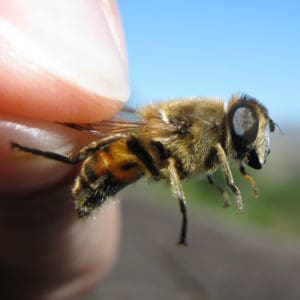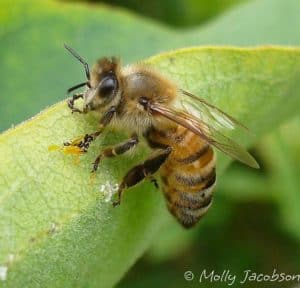At a glance can you tell who the imposter is? Honeybee mimics like the drone fly, shown on the above left, have been able to fool many people, especially when you just glance at one out of the corner of your eye.
But why does this fly, and other mimics go through the trouble of imitating another organism? How can we easily tell what’s a bee and what’s not? And why would we want to do such a thing anyway?
As it turns out mimics of many types exist for many reasons. These include protection from predators, which would be referred to as batesian or mullerian mimicry, or to gain resources such as food or habitat referred to as aggressive mimicry (Ceccarelli 2013). Just check out this Bumble bee mimic feeding on an unsuspecting beetle that might not anticipate a bumble bee as a predator.
In the case of the honey bee mimic above, danger avoidance seems most likely. One study showed that when a monkey captures a bee mimic it lets it go after a few seconds, as if the fly were a bee stinging its hand. Other animals such as lizards and spiders have also demonstrated an avoidance of the drone fly after an encounter with a honeybee. (Brower & Brower 1965)
So why do we care about spotting mimics? With the loss of pollinator diversity we are likely experiencing, there has been a movement to try and catalog just how many types of pollinators, and particularly native bees we actually have. How could you know you lost something if you didn’t know it was there in the first place? This kind of effort relies on citizen science, or the combined efforts of the general public to provide the data. One group that does this is called Beespotter, a group thatbegan in the Midwest and is expanding its efforts across the United States.
Their webpage provides easy tricks for how to tell a mimic from a bee. Luckily if you are in the know, it’s pretty easy to tell the imposter from the real thing with a few simple clues, the easiest being to count the wings! Flies will never have more than two wings, because their hind two wings have been replaced by small knobbed stalks called halters. Every kind of bee will always have four wings.
So now that you know how to tell the difference between a fly and a bee, try and see how many different types of bees you notice out and about this summer! Many of us spend a lot of time outdoors, so maybe even grab a camera and join Beespotter to contribute as a citizen scientist.
Works Cited:
- Beespotter webpage http://beespotter.mste.illinois.edu/topics/mimics/
- Brower, J. Brower, L. “Experimental Studies of Mimicry. 8. Further Investigations of Honeybees (Apis mellifera) and Their Dronefly Mimics (Eristalis spp.)” the American Naturalist. Vol. 99, No. 906 (May – Jun., 1965), pp. 173-187
-
Ceccarelli, F. “Ant-Mimicking Spiders: Strategies for Living with Social Insects.” Psyche vol.2013
- Pictures from Bugguide.net

